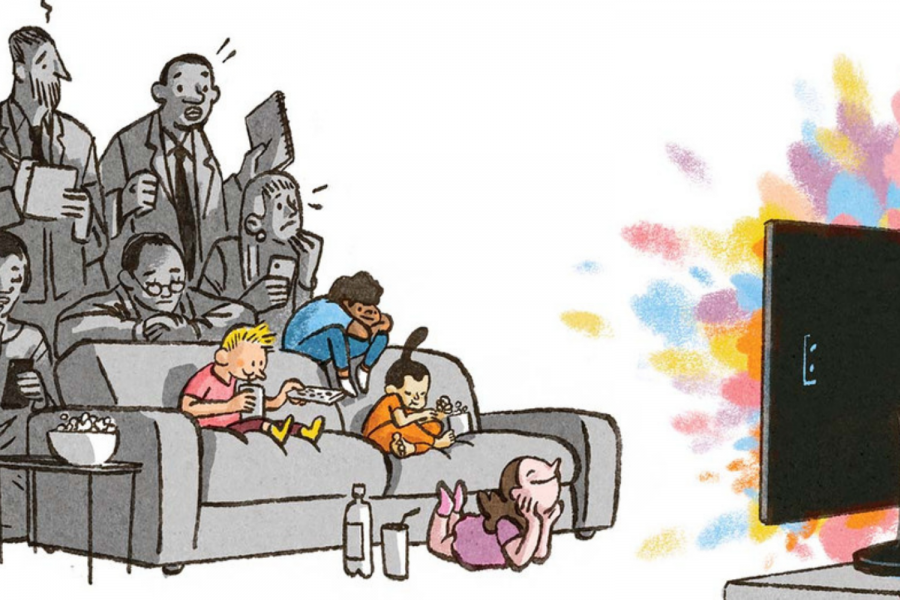Illustration by Luis Mendo via Hollywood Reporter
Media in all forms create stereotypes that influence us early on
Opinion: The not-so casual racism of our favorite childhood TV shows
The normalization of casual racism in children's media is an unsettling issue
December 1, 2020
I still remember the pure bliss that I felt at exactly 4 p.m. on the weekend. My mom finally handed over the TV remote, and I sat in my SpongeBob bean bag chair for hours on end, watching reruns of “Adventure Time,” “Regular Show,” and “Jessie.” Only recently, when I started rewatching some of the most popular television shows from less than a decade ago, did I notice the glaring racial stereotypes that were embedded in children’s minds — including my own.
Directors simply sprinkled in two or three people of color into every show I watched. Many shows seem to misinterpret a yearning by the public for diversity as a way to throw any person of color into an acting role and push a damaging stereotype. Misrepresenting a certain group of people seems to be more destructive than no representation at all.
I have to admit, the Disney show “Jessie” was enthralling. The quirky plotline and amusing roles like Bertram and the lizard, Mrs. Kipling, kept me glued to my couch. It was also one of my first introductions to Indian representation in American media as the show included a young and dorky Indian boy named Ravi. However, the show forced a variety of harmful stereotypes towards African Americans and South Asians. The character Ravi represented an Indian immigrant with a thick accent and no social skills. Rewatching the show, I noticed every five minutes, Ravi seemed to refer to India. In turn, I surely grew to associate his nerdy characteristics with India. Another character, Zuri, represented an adoptee from Uganda. Zuri evolved from being compassionate and sweet to sassy and spoiled. The writers heavily pushed the “angry Black girl” stereotype as Zuri managed to always get her way due to her stubbornness. It was exhausting rewatching this show as the writers forced the only people of color to push a soulless and ill-thought-out narrative.
The show “Phineas and Ferb” and the movie “Diary of a Wimpy Kid” also had an Indian character. And as one might expect, their characters, Baljeet and Chirag, had a synonymous identity to Ravi: socially inept boys with nerdy interests and a thick accent. Sure, it’s great to have representation. But, when the characters are forcing cringe-worthy identities providing no relatability to viewers, accurate representation is much more valuable.
So it’s not much of a surprise that, as an Indian, I have been expected by other students to have the same identity as Ravi. The remarks I have been told reflect this misrepresentation as students only familiarity of Indian people is through American media: Apu in the Simpsons and Ravi in Jessie. When I searched for pictures to add to this article, I came across a side-by-side photo of Ravi and a violent terrorist group leader. The caption stated, “this is Ravi now. Feel old yet?”. This ignorant spread of racism might seem harmless to people, but they can evolve into deadly issues like hate crimes.
It was disheartening rewatching the shows I used to binge for hours on end. I hoped to find at least a few positive representations of characters with the same racial background as me. In the last decade, I think that representation has improved with movies like “Moonlight,” “Lion,” and “Get Out.” However, media designed for children still heavily lacks diversity. People of color are generally cast as side-characters or are forced to push stereotypes. In the future, I hope children start to see more characters who look like them. The world needs characters that provide deep connections and mirrored reflections of viewers.


Rayelyn Burrell • Dec 13, 2020 at 3:03 am
This is a really awesome story, I really enjoy the way you shined a light on this issue of misrepresentation and racial stereotypes embedded within these childhood shows. Insanely great job.